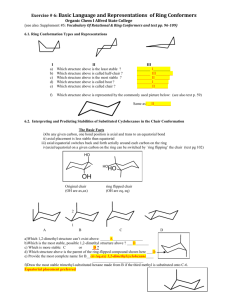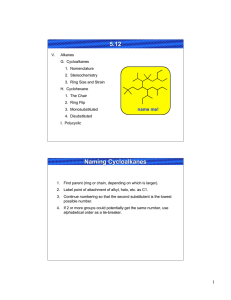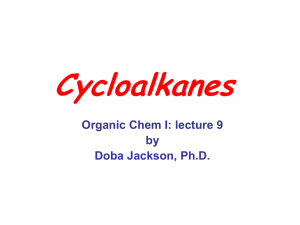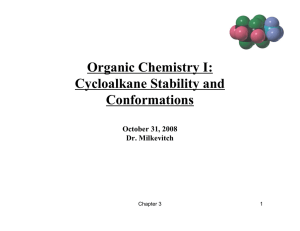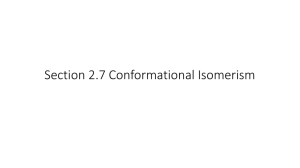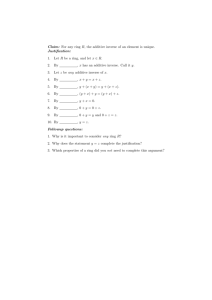Alicyclic Chemistry. Lecture 3 The overall strain in cycloalkenes can
advertisement
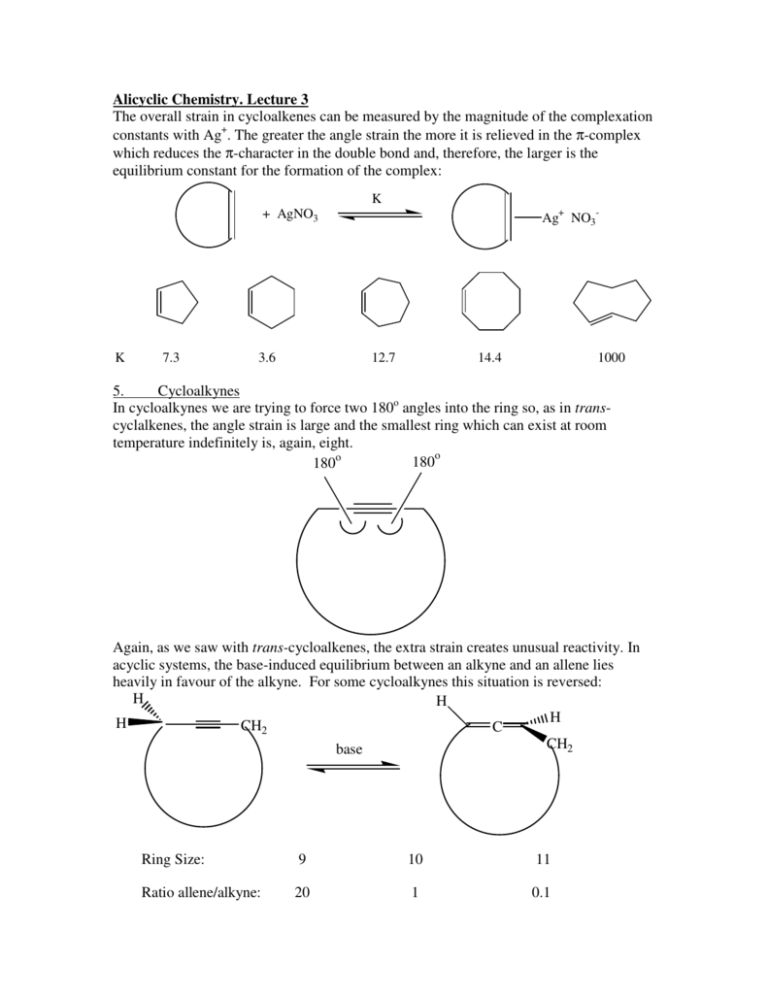
Alicyclic Chemistry. Lecture 3 The overall strain in cycloalkenes can be measured by the magnitude of the complexation constants with Ag+. The greater the angle strain the more it is relieved in the π-complex which reduces the π-character in the double bond and, therefore, the larger is the equilibrium constant for the formation of the complex: + AgNO3 K 7.3 3.6 K Ag+ NO3- 12.7 14.4 1000 5. Cycloalkynes In cycloalkynes we are trying to force two 180o angles into the ring so, as in transcyclalkenes, the angle strain is large and the smallest ring which can exist at room temperature indefinitely is, again, eight. 180o 180o Again, as we saw with trans-cycloalkenes, the extra strain creates unusual reactivity. In acyclic systems, the base-induced equilibrium between an alkyne and an allene lies heavily in favour of the alkyne. For some cycloalkynes this situation is reversed: H H H H CH2 C CH2 base Ring Size: 9 10 11 Ratio allene/alkyne: 20 1 0.1 Some of the Strain of Organic Chemistry a) Synthetic Cubane: P. E. Eaton, T. W. Cole, J. Am. Chem. Soc., 1964, 86, 962, 3157 Prismane: T. J. Katz, N. Acta, J. Am. Chem. Soc., 1973, 95, 2738 tBu tBu tBu The only Tetrahedrane: G. Maier, S. Priefen, H. Schafer, R. Matusch, Angew. Chem. Int. Ed. Eng., 1978, 17, 520 tBu 1,1,1-Propellane: K. B. Wiberg, F. H. Walker, J. Am. Chem. Soc., 1982, 104, 5239 Cyclooctadiyne: E. Kloster-Jensem, J. Linz, Angew. Chem. Int. Ed. Eng., 1973, 12, 671. b) Natural (CH2)7CO2H CH3(CH2)8 Sterculic acid: J. R. Nunn, J. Chem. Soc., 1952, 313 O (CH2)nCO2H Alutacenoic acids A(n=5) and B(n=7): H. Kogen, T. Kiho, K. Tago, S. Miyamoto, T. Fujioka, N. Otsuka, K. Suzuki-Konagai, T. Ogita, J. Am. Chem. Soc., 2000, 122, 1842. β-Caryophyllene: T. L. Dawson, G. R. Ramage, B. Wilson, J. Chem. Soc., 1951, 3382 O R 2O O 1 R O O O Neocarzinostatin: K. Edo, M. Mizuyaki, Y. Koida, H. Seto, K. Furukata, N. Otake, N. Ishida, Tetrahedron Lett., 1985, 26, 331. Conformational Analysis You have seen how conformations influence reactivity in the first year e.g. the E2 elimination mechanism requires that molecule adopts a conformation such that the departing groups (usually HX) are anti-periplanar. Here we study the general effect of conformation on the kinetics of all sorts of reactions in cyclohexane rings where the phenomenon is much greater because of the relative rigidity of six-membered rings compared to acyclic molecules. Such a study is called Conformational Analysis. Before we look at the kinetic side, however, we need first to consider some thermodynamic aspects. 1. Conformations of Cyclohexane There are two limiting (i.e. have a maximum or minimum energy) conformations of cyclohexane, the boat and the chair: Energy ~21 KJmole-1 Since most cyclohexanes exist in the chair form rather than the much higher energy boat form, conformational analysis is almost exclusively applied to substituents on cyclohexanes in the chair conformation. The simplest substituent is hydrogen and, in principle, there are two types of hydrogen in cyclohexane depending upon their orientation in space: C3 axis axial equatorial There are six hydrogens projecting parallel to a C3 axis of symmetry through the centre of the ring (axial) and there are six hydrogens which project around the equator of that axis (equatorial). Thus, in principle, we might expect to see two lines in an 1H nmr spectrum of cyclohexane. In practice, there is only one line because both types of hydrogen are rapidly exchanging places during the time of the nmr recording, not by bond cleavage but simply by rotations about a number of single C-C bonds, a conformational flexing called Ring Flipping: Hx(ax) Hx(ax) Hy(eq) Hy(eq) Hx(eq) Hy(ax) Since we wish to know the influence of conformation upon the reactivity of substituents we now turn to substituted cyclohexanes. Here the same ring flipping can occur so that the substituent may adopt an axial or an equatorial position: X H H X In the axial position the two hydrogens (shown) which are 1,3-related to X come within repulsive force distance to X and hence a destabilising compression is set up. This is known as 1,3-Diaxial Compression. In the equatorial position the nearest neighbours are the 1,2-equatorial hydrogens which are pointing away from X. Thus the equilibrium usually lies over on the side of that conformation in which X is in an equatorial position. The extent of this disturbance will obviously depend on the size of X as the following table shows: Group Free energy difference (eq/ax) (kJ mole-1) Equilibrium Ratio(eq:ax) F Cl Br I 1.1 2.2 2.9 2.9 2.4 : 1 3.4 : 1 3.4 : 1 Me Et iPr tBu 7.6 9.2 10.0 >21.0 23 : 1 47 : 1 65 : 1 >6300 : 1 SiMe3 GeMe3 SnMe3 PbMe3 HgCl 10.6 8.9 4.2 3.0 0 1:1 Ph 11.0 100 : 1 CN OAc CO2H CO2Et OH(free) OH(H-bond) OMe NO2 0.7 1.5 5.7 5.1 2.2 3.7 2.5 4.9 1.9 : 1 In conformational analysis we wish to see how the reactivity of a group in an axial position differs from the same group in an equatorial position and, therefore, we need to stop ring flipping. One way to do this is to put a tert-butyl group on the ring since from the Table we can see that this freezes the ring into that conformation in which the t-Bu group remains equatorial. However, such ring compounds are not readily available. Alternatively, we can use a system known as trans-decalin in which two six-membered rings are fused together: H H e e A B e e H H If we were to try and ring flip either ring A or ring B those equatorial bonds (marked e) would become axial and the remaining ring would break (try this on a model). A naturally occurring and readily available series of compounds containing the transdecalin system is the Steroids and, historically, it was this group of compounds which provided the testing ground for conformational analysis. β-face Me 1 Me 2 5 3 4 Me H H H B e e 7 H e e A H H 6 H For example 3β-cholestanol: α-face Me Me Me H H HO H H Me H
